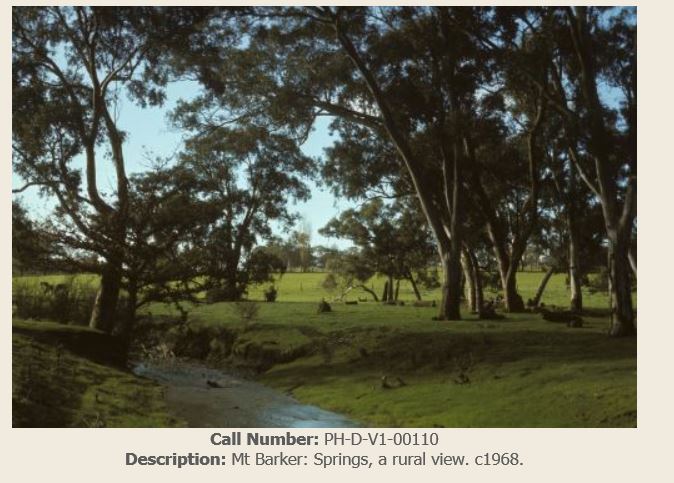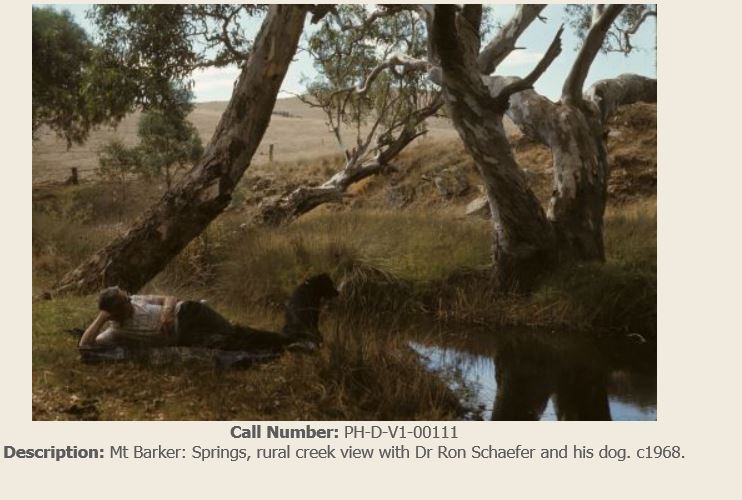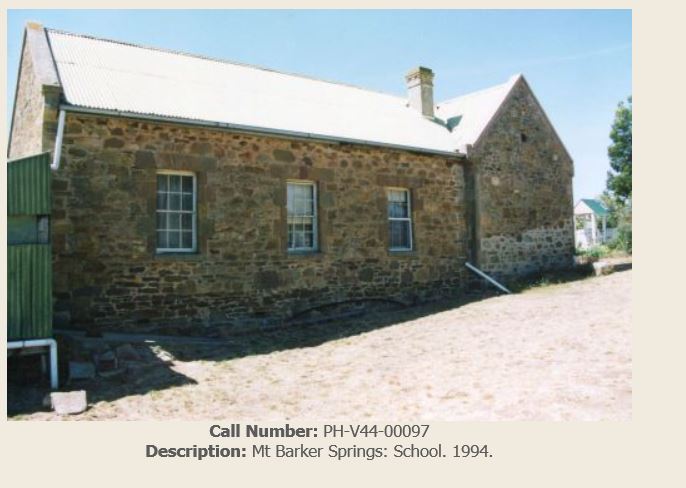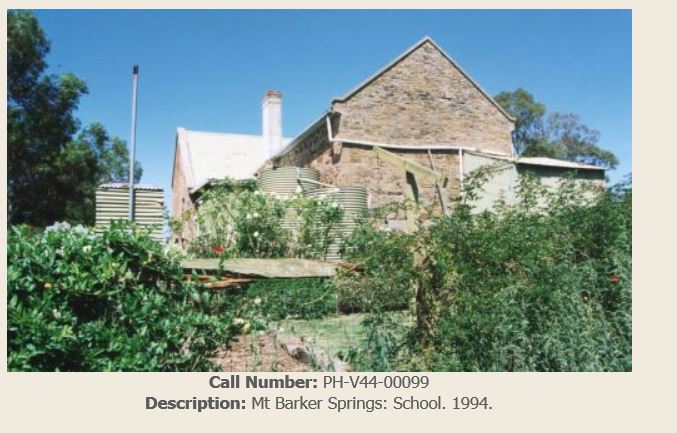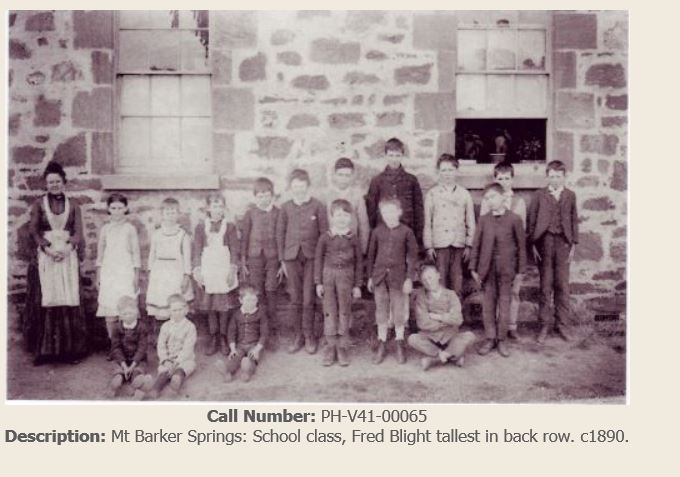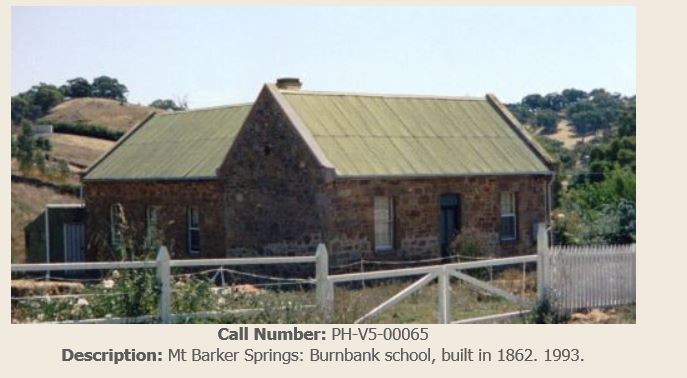Hope Springs History
History of Burnbank School
Hope Springs Eternal is the site of the former Burnbank School. The building is heritage listed and a part of the local area’s history, as follows:
The community at the small settlement of Mount Barker Springs, 3 km east
of Mount Barker, joined together to build the school house in 1862. It was a
fee paying school (sixpence to one shilling per week) and designed by its first
School master, Mr Scheckleford on land donated by Mr John Frame. The local
children were educated at Burnbank School until 1910. The building then
remained empty for 10 years, when it, and the surrounding land was purchased
back by the Frame family.
Among
its notable students in the very early days were Sir Langdon Bonython,
journalist and philanthropist and Dr C T Madigan, a Rhodes Scholar, Geologist
and member of Douglas Mawson’s Antarctic expedition.
The School House is constructed of beautiful local stone. In
parts these walls are 475mm thick keeping the building well insulated all year
round. Initials have been carved into the
stone by mischievous past students. Originally the school house had a timber
shingle roof. There is now a colourbond roof covering the shingles, but they
still provide extra insulation to the school house which has now been converted
into this heavenly home.
The headmaster and his wife lived in the front section having his sitting
room with an open fireplace, and his bedroom at the front of the house. Two
steps lead down from the timber floored hallway into the large Kitchen which is
now disposed as the family bathroom, with an old cast iron claw foot bath,
toilet and vanity.
The large main room was the school-room – though it would have doubled as the sleeping area for the family’s six children. Where an old lean to used to be for the students to hang their bags, there is now a laundry and additional bedroom built on.
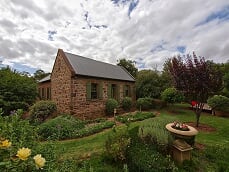
Mount Barker Springs
Combined Extracts from The Mount Barker Courier and Onkaparinga and Gumeracha Advertiser
Dated: 27 September 1951, 4 October 1951, 11 October 1951, 18 October 1951, 15 November 1951, and 22 November 1951.
Includes historical information by Mrs E. MacLeod on Mount Barker Springs
“In opening my address upon Mount Barker Springs, I would go back to the years ensuing from December 1836 when the first white people began to arrive in South Australia and many small parties of migrants sailed forth from England in such ships as the Buffalo, Investigator, Endeavour, Buckinghamshire and the Marianna. Some of those earlysettlers migrated from Sussex and Yarmouth. The voyages from England occupied six months ocean travel and sometimes longer depending upon the elements and the condition of the vessels in which they sailed.
With the landing and settling of these migrants in Black Australia, it thus set out on its way to become known as White Australia. Those migrants became the pioneers of the vast unknown country, for, when they landed it was not the well mapped out area that it is today as dense scrub and forest prevailed. Some of the pioneers took different tracks, but transport was difficult as primarily, it was a matter of walking and at the outset there were but two horses in the colony, one owned by the South Australian Company and the other by Mr. (later Sir John) Morphett.
They followed the blackfellow’s tracks and some of the present day roads are surveyed on those native pathways and towns upon their one time camping grounds. A small party wended its way to one of the most historical town ships, Mount Barker which had been first sighted by Captain Charles Sturt when he had readied Lake Alexandrina on his historical voyage down the mighty Murray in 1830. He thought it was Mount Lofty. In 1831 Captain Collett Barker, on his way from King George’s Sound in Western Australia where he had been employed was directed by the Governor Gulf where he arrived in April Of New South Wales to call at 1831. His object was to find Encounter Bay in St. Vincent’s some communication, if any existed, between Lake Alexandria and the Gulf.
Finding none, he penetrated in company with Mr. Kent as far in land as Mount Lofty and from that height they saw before them the beautiful plains on which Adelaide is situated. They again examined the ground and crossed the country east ward to Lake Alexandria. When they had gone this far, they made their way to the channel through which the river Murray flows into the sea. Barker thought it was about a quarter of a mile wide and decided to swim across it in order to take some bearings from a sandhill on the other side. His companions waited, after he had crossed in safety; they waited for hours but he did not return. Fires were seen all around the sandhill he had ascended. They returned to their ship and went to Kangaroo Island where they procured the aid of a black woman and two sealers. They at last learned that Captain Barker had been speared by the blacks who were in great numbers where he had landed. And Mount Barker perpetuates the name of that intrepid explorer.
As the years passed many parties ascended Mount Barker among which may be mentioned those led by John Morphett, John W. Bull and Hawdon when he brought the first mob of cattle overland to Adelaide. Also, there was William Beavis Randell the father of the town of Gumeracha who had that town surveyed and sold the blocks as he had purchased the area. He had been at the outset employed by the South Australian Company in discovering the best grazing land in the young colony and upon his reports the first Mount Barker special survey was taken out.
It was claimed by J. B. Shepherdson in 1892 that on Christmas Day 1838, he and W. B. Randell were the first to climb Mount Barker after Captain Collett Barker. The blackfellow’s name’ for the Mount was Womnia MuKurta and the name of the tribe was the ‘Peramgha.’ The language of the aborigines differs in each tribe and also there is a variation in their corroborees. Those aborigines were primitive in their way of living but were fairly intelligent. They never stayed in one place for very long because they were ignorant regarding the cultivation of food and what is more, they had no cereals as we know them to harvest.
There was a large camp at the foot of Mount Barker on the Springs Reserve. A large water hole and gum tree marks the spot where they lived in their native homes, called Gunyahs which were made of mud and branches of trees. It was estimated that at about that time there were four million blacks in Australia, far exceeding the white settlers. Now the pendulum has swung in the other direction. The first settlers arrived at Mount Barker Springs on September 11th 1837 and the first white people to arrive camped along the creek and made houses of wattle and daub and slab huts. The roofs were formed of boughs of trees and dried grass. Some of the present day houses are built on the exact spot where those aborigines camped, such as ‘Burnhank,’ ‘Harper’s Corner,’ ‘Spring Head’ and many others.
There are quite a few springs at the foot of the Mount and that is how it came by the name of Mount Barker Springs. Among the aborigines there were no such things as calendar dates or records. They referred only to ‘many moons.’ Half a moon was about two weeks. The pioneers of the early days had to be as it were hypersensitive and know the difference between sincerity and technique as one never knew if a black fellow was sincere or hostile. They had as it were a dual or split personality.
In the early days Mount Barker Springs was a cattle run and the names that are recalled in association with such activities are McFarlane, J. B. Hack, Dutton, Fenn, Jones, Captain Finnis, ,Bourchxer, Scott and Milne. About 1838 in February what were called the “Overlanders” came from New South Wales bringing about 400 head of cattle for the people to feed and milk. The settlers carried the butter they had made, and also the eggs all the way to Adelaide in baskets on their backs if they were not possessed of a bullock waggon. The names of a few of the settlers I recall are Messrs Bell, Bonython, Blight, Collins, Cleggett, Callaby, Frame, Harper, Hendry, Kavanagh, Paterson, Hall, Mould, Morphett, Finnis, Lang, Neagle, Oborn, Rider, Stokes, Stephenson, Snell, Shepherd, Champion, Teakle and Webber. With these men were their wives and children.
They also brought with them seeds and vine cuttings. Stephen Page came out in the Buffalo in 1836 from Yarmouth. He was a master plasterer and builder. His main work was the erection of public places such as banks, post offices and churches, some of his most skillful work being the erection of church spires. The Echunga Church of England was erected under his supervision and it was built by volunteer labour. Alfred Champion was one of the first organists at Mount Barker Springs and also conducted the choir. The baton used for the choirs is still here and also the first bible used in the Mount Barker Springs church.
Most of those people I have mentioned before were skilled craftsmen in their various trades such as carpenters, cabinet makers, builders, foundry men, tanners, miners, etc. Food and clothing being the main problem, and production one of the main objectives for the first few years. The fundamental, uses of the material provided by nature was greatly appreciated by those pioneers and full use was made of the ‘Springs’ after which the district is named. Almost all of the homesteads had springs in their vicinity. A Mr. Mould, a cabinet maker used the natural woods, for the making of the furniture – sheoak, wild cherry and mountain gum that he obtained from the Mount. He also made all kinds, of wooden implements such as ploughs, flails, etc. They were all hand made and the timber was pit sawn. Some of that old furniture made by Mr. Mould is still in use. He was over ninety years of age when he died.
The excellence of the craftmanship of those pioneers died with them and no one but the pioneers themselves know the privations and desperate straits through which they passed. Determination and faith in God and themselves assisted them to pave the way for those who followed, and they did not possess the labor saving implements of the present day. And many moons passed, still no dates, and so did some of the pioneers. As conditions improved and the population increased activities and interests developed, and the district widened to a radius of three miles. It was in 1847 that the population received an increase by the opening up of the Callington mines . A new road, which followed the track up Harper’s Hill was opened, thence up Bonython’s old road through the property now owned by Blights and down across the creek.
One of the pillars still stands which formed the bridge over the creek; the other one was washed away by floodwaters. Then the road proceeded past a stone wall which was built by the settlers, and along to the Flying Fox. A few old walls and parts of old mud houses still stand as relics of the activity of men long since passed away. Men who once worked the mines which are now full of water. Mr. Harper was the Captain and Messrs Bonython, Snell and Collins were pitmen. There are old houses in Mount Barker Springs that are still being used viz, Hendry’s old house, built of stone in 1852 and Patterson’s, built in 1854, now owned by Mr. Carr. The other is at Harper’s Corner, built in 1842.
The churches of the district provided quite a history of their own, notably the Blakiston church which is the third oldest in the state, built in first years of the fifth decade of the nineteenth century; and services are still preached in that church every Sunday. Mount Barker people were christened and married in that church. The remains of many old church buildings still stand. They are situated on the old road known as Blight’s road, Hender’s road and Mould’s road. Many of the Pioneers such as Collins, Henders, Bonython and Snell are buried in those church yards and some of their tombs are still existent. Mr Hender and Harper were the founders of the churches. Mr. Harper, being a preacher on Sundays, always wore a top hat and swallow-tail coat.
The church at Lang’s Hill stands on the ground donated by Mr. Lang and was built in 1842. The Springs school was erected in about 1862 and at the same time services were held there on Sundays. It is strange to recall that fifty years ago pine trees were planted around the school on Arbor Day. At the school at that time were Kavanagh, Winnie and Mary Kavanagh, Darcy, Cliff and Don Wollaston, Mitchell, Cleggett, Choat, Neagle, Harper and Frame. The teachers were Mrs Stow and Mrs. Morgan. In 1870, Mr. Harper taught in the school when other pedagogues were not available. In 1864 Mr. Evans was brought from England also a Mrs. Tresyse, Mrs. Stow, Mrs. Morgan and Mrs. Madigan. The ground for the school was given by Mr J. Frame the second. The school was bought by Mr. J. L. Frame.
Some of the descendants of those persons are today well known citizens, viz, Bonython, Mrs. Madigan, Messrs Paul and Cecil Madigan. Paul Madigan was a well known explorer, the son of the school teacher Mrs Madigan. Sir Langdon was and Sir Lavington is well known as a patron of the Adelaide University. Sir Langdon, a part owner of the ‘Advertiser’ and ‘Chronicle’ newspapers was educated at the Mount Barker Springs school and was taught, until he was thirteen years of age by Mrs. Harper. Mr. Lang drove him in a bullock dray to Adelaide to get a job as an office boy in the ‘Advertiser office where in later years he became the owner of that paper.
Just across the road used to be Callabys old slip rail where many a yarn was swapped by the sundowners and the swaggies as they were termed. They wore mole-skin trousers, bow yangs with their swags thrown over their shoulders and a billy-can in their hand. Thus they travelled the bushlands of Australia. Mr. Harper had a store and kept the post office at the Springs in 1851. He was a well educated man and a preacher and teacher. His ancestors were Harpers of Lloyds of England.
Mrs. Harper and Mrs. Collins were the first two people to possess a horse and cart in the district to take their butter and eggs and cheese to Adelaide and bring back goods for themselves and their neighbours. There was a lime kiln on Stephenson’s Hill from which the people obtained their lime to build their homes — homes in which some people live at the present time. Two notable achievements of the Springs were the prizes won for wheat in the immediate area and at Burn Bank owned by Mr. L. J. Frame of the fifth generation of that family. The other wheat was grown at Dalmany by Mr.Bell and was shown at the London Royal Exhibition winning the champion prize.
Some of these old pioneers lived in hope and died in despair. Others lived on the humanitarian’s generosity and faith. To celebrate the 100 years centenary, a road was made up to the top of the Mount. From it may be enjoyed one of the most picturesque views for miles distant. The Mount Barker creek winds its way around in the bottom of the valley and it is a delightful experience to go for a hike along it amid the beautiful spots made in nature’s own way. Those scenes are quite equal to any American grand canyons. The creek winds its way to the Bremer river and there are some lovely waterfalls in its course. And then on to the great lakes of Alexandrina and Albert.
Nowadays many people in their modern day motorcars drive to the summit of the mountain, and those who set out upon a tour should never miss the enjoyment of a panoramic view thus obtainable as it stretches out into the illimitable distance. In 1939 another notable centenary was celebrated and upon that occasion trees were planted, each one bearing the name of a pioneer. They are placed on the main Adelaide road leading to the town for about a mile on either side.

